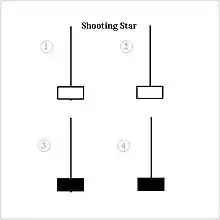
In technical analysis, a shooting star is interpreted as a type of reversal pattern presaging a falling price. The Shooting Star looks exactly the same as the Inverted hammer, but instead of being found in a downtrend it is found in an uptrend and thus has different implications. Like the Inverted hammer it is made up of a candle with a small lower body, little or no lower wick, and a long upper wick that is at least two times the size of the lower body.
The long upper wick of the candlestick pattern indicates that the buyers drove prices up at some point during the period in which the candle was formed but encountered selling pressure which drove prices back down for the period to close near to where they opened. As this occurred in an uptrend the selling pressure is seen as a potential reversal sign. After encountering this pattern traders often check for a lower open on the next period before considering the sell-signal valid.
As with the Inverted hammer most traders will see a longer wick as a sign of a greater potential reversal and like to see an increase in volume on the day the Shooting Star forms.
The pattern consists of three key elements
- Small Body: The small body of the candle is situated at the bottom, indicating a modest difference between the opening and closing prices. This reflects a relatively indecisive market at the beginning of the formation.
- Long Upper Shadow: The most captivating feature of the Shooting Star is its extended upper shadow, symbolizing a valiant attempt by the bulls to push prices higher. However, as the session progresses, the bears take control, pulling the price back down and creating the distinctive shape of the candle.
- Little to No Lower Shadow: The absence or minimal presence of a lower shadow suggests that the bears were successful in driving prices down without much opposition.
See also
- Inverted hammer — Shooting star pattern found in a downtrend